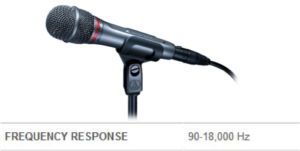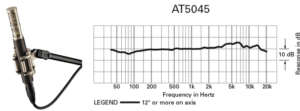Question: What is a microphone’s frequency response and why is it important to know?
Answer: A few weeks back, our blog post “What Do Microphone Specifications Mean?” talked about some common microphone measurements. One of those was frequency response, which is a measurement of how a particular microphone responds to a range of frequencies. Now that you know what the specification means, let’s look at why it is important.

Frequency response is often presented as the range of frequencies that the microphone can “hear” and reproduce. As you may know, the typical human ear, at birth, can hear sounds ranging from 20 to 20,000 Hz, though that ability may decrease for various reasons as a person ages. Many microphones have a frequency response that falls within that same 20–20,000 Hz range. While possible, it is rare for a microphone’s frequency response to exceed that range of human hearing. However, some microphones may intentionally attenuate frequencies on the low end in order to reduce rumble. Vocal microphones, for example, often cut out – or include a switch for the choice to cut out – frequencies 80 Hz and below. Other microphones may intentionally attenuate higher frequencies to reduce unwanted high-frequency noise. A popular professional microphone that illustrates both of these characteristics is the AE4100. The low and high ends of the frequency response are important factors to consider when selecting microphones for particular applications, or when you know which frequencies you want to accentuate or avoid.
Frequency response is also commonly represented by a graph that is similar to an equalization curve. This graph shows the relation of the X axis (horizontal) frequencies to the Y axis (vertical) fluctuation of voltage (volume.) You may follow the measured response along the entire span of the frequencies. This will allow you to identify which frequencies are accented or diminished. For instance, in looking at the example below of the AT5045, you can see that there is a slight increase in volume around 5 kHz, a characteristic that is often used to emphasize presence. Again, such information can be important when choosing microphones for particular applications, or when you know which frequencies you want to accentuate or avoid. The AT5045 microphone is a great choice for instruments since the frequency response is tailored for instrument crispness and true fidelity.

These measurement tools can also be helpful in differentiating between microphones, such as when choosing drum microphones. Kick drum microphones will probably have a different frequency response than a microphone used for drum overheads. The ATM250 microphone has a frequency response that has a bump around 80-120 Hz for the low-end “thump” of the drum as well as a drop-off in the higher frequencies starting around 10 kHz. The AE5100 microphone is great for drum overheads, with a flat frequency response for accurate reproduction of the cymbals as well as the overall drum kit. The mic also has a switchable low-end roll-off around 80 Hz and a natural frequency lift around 5 kHz for clarity.
Stop back here for our next Question of the Week when we’ll discuss the sensitivity specification and why it is important to know. If you have further questions, feel free to contact the Audio Solutions Department.